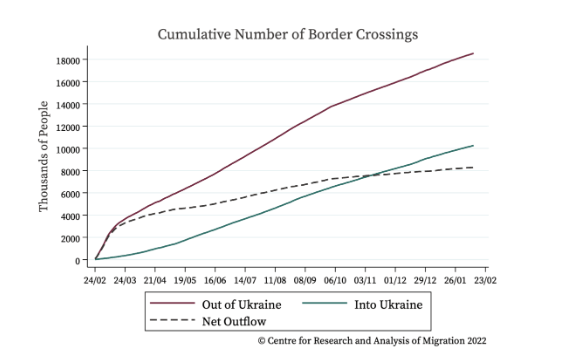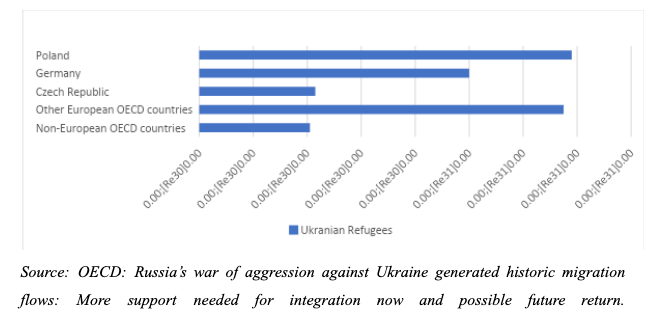Güzin Yağmur Baltacı
Göç Çalışmaları Stajyeri
Editör: Ayşenur Alişiroğlu
Introduction
Since Russia invaded Ukraine on 24 February 2022, millions of Ukrainians have been displaced from their homes and countries. Inevitably, this historical movement has created a migration flow. In the shadow of that human cost, this paper initially analyzes which definition of migration fits the Ukrainian case the best after giving a brief summary of the situation. Then, it looks at where this migration wind blows and the reasons for densities. Finally, it examines Europe’s attitude in the face of different migration-related situations and in the case of Ukraine by shedding light on its migration policy.
Background and Current Situation
The roots of the current war can be traced back to Russia’s annexation of Crimea in 2014. Russian troops took control of Crimea to protect Russian citizens and their rights in Crimea according to Vladimir Putin (Global Conflict Tracker 2023). While the armed conflict between the Ukrainian military and Russian troops continues, the North Atlantic Treaty Organization (NATO) took some precautions to deter Russia from possible future attacks both on the continent and Baltics. In addition to that, USA introduced some new sanctions to strengthen NATO’s presence in the region. However, both the current situation and the invasion on February 24, 2022, show that these sanctions and efforts have not been deterring enough for Russia and Putin, who describes the invasion as a “special military operation” to demilitarize Ukraine and hinder the alleged genocide of Russians in Ukraine (Global Conflict Tracker 2023). Currently, attacks on Kyiv, Kharkiv, Lviv, and Odesa continue, including Bakhmut as a heavy fighting zone (BBC News 2023). The invasion, which Human Rights Watch considers a violation of international humanitarian law, has had devastating effects on civil life and property (Human Rights Watch 2023).
In the international context, this invasion has shaken the balance of power and further polarized relations between the United States, European countries and Russia. Therefore, this situation has led to global crises concerning various aspects of politics such as resource markets, stability, security, and migration, which is the focus of this paper.
Migration
European Commission defines migration as “movement of a person either across an international border (international migration), or within a state (internal migration) for more than one year irrespective of the causes, voluntary or involuntary, and the means, regular or irregular, used to migrate” (2023). According to this definition, this paper considers international, involuntary and regular migration to be applicable for the Ukrainian case because Ukrainian migration concentrates in Europe (Operational Data Portal 2023) and international migration is more suitable for data availability; it is clear that this is an involuntary migration as a result of Russian invasion and in order to provide data, regular migration is considered.
For further clarity on terminology used, international migration is the movement of a person across an international border (European Commission 2023). Involuntary migration is a term which is used for “migrants those forced to migrate due to conflict in their countries of origin, as opposed to ‘voluntarily’ for economic opportunity or other reasons” (Gisselquist 2021). Regular migration can be defined as “the administration of measures related to authorized movement of persons” (International Organization for Migration 2023).
Migration Flow for Ukrainians
According to OECD’s International Migration Outlook (2022), Russian invasion of Ukraine has led to a historic outflow of refugees. Millions of refugeed have crossed borders into neighboring countries and many of them have been forced to move inside the country (Operational Data Portal 2023).
Table 1: Cumulative Number of Border Crossings

As seen in Table 1, this migration trend mostly manifests as international migration. Besides, to be able to provide sufficient data, this paper only considers international migration rather than internal displacement. According to United Nations High Commissioner for Refugees’ (UNHCR) latest report (Operational Data Portal 2023), there are 8.207.977 individual refugees from Ukraine across Europe. This number shows that the Ukrainian migration density is primarily in Europe.
Table 2: Ukrainian Refugees: Number of Refugees from Ukraine in OECD countries,
mid-September 2022, millions

As observed in Table 2, Ukrainian refugees mostly migrate to Central and Eastern European countries. There are possible reasons for this flow as well as the welcoming attitude of receiving countries. One of them is partial freedom of movement within Europe of Ukrainian citizens as a result of European Neighborhood Policy (ENP). Thanks to this agreement to which Ukraine is signatory, Ukrainian citizens are granted visa-free travel in the Schengen Area (Drazanova 2022).
As a historical memory feature, Drazanova (2022) suggests that most of the Central and Eastern European countries have considered Russia as an existential threat as a result of their political history memories in which they were living under the Soviet influence. Therefore, this permanent memory led them to easily unite and mobilize against one external threat. In addition to that, it is quite possible that this memory also activated a sense of empathy and they acted with the feeling of “we could be the next”.
The third reason that Drazanova (2022) mentions is the interpersonal contact as a result of the significance of the Ukrainian diaspora in the Central and Eastern European region even before the Russian invasion in February 2022. This shows that receiving countries already have experience co-existing with Ukrainians; thus, this is not new for them, and it can be said that the positive effect of bonds that have already been formed has also been largely effective.
All the reasons above reveal both the welcoming attitude of the receiving countries and the reason why Ukrainian migration flows are dense in this region. On the other hand, besides the European countries, the second migration density point has is in Russia, the invading country. The reason for this behavior, which can be considered as entering a bear’s den in every sense, is stated by Gavali (Gavali 2023); despite reports of forced transfers, Russia claims that they are helping people to move without force.
Even though both Russia and Ukraine have agreed on the number of refugees that have arrived in Russia, nearly 2 million; they cannot reach an agreement on how to portray these journeys. While Russia claims that it is a “humanitarian evacuations of war victims who already speak Russian and are grateful for a new home”, Ukraine claims that these are forced transfers (Lori Hinnat 2022). It is also important to mention that Human Rights Watch (2023) also considers these transfers to be war crimes because they also consider these to be forced transfer to either Russia or Russian-occupied cities of Ukraine. It can be understood that if Ukrainian people who do not have any other place to go and have relatives in Russia, they might choose to go to Russia to have a more stable life. On the other hand, it is hard to believe that they would willingly migrate to Russia while they have numerous and arguably better options, such as the Central and Eastern European region.
EU’s Attitude Towards Migration
It is known that most of the European countries, even Central and Eastern European countries who are friendly towards Ukrainian refugees, do not have positive attitude towards Muslim refugees from Syria, Iraq, etc. When it comes to Ukrainian refugees, it can be observed that their attitude is much more different as a result of common culture, religion, geographic proximity and history. According to Operational Data Portal (2023), 5.093.606 refugees from Ukraine registered for temporary protection status or similar national protection schemes in Europe. This number is higher than half of the refugees that are recorded across Europe. Also, UNHCR has published that millions of refugees from Ukraine accessed various forms of support such as protection services, essential items, cash assistance, shelter and housing support as well as safe access to multi-sectoral services.
This double-standard demonstrated by the EU countries reveals itself mostly when we consider the 2015 “refugee crisis”. Also, the positive and stable attitude towards Ukrainian refugees shows that European Union can produce and apply the global refugee protection regime with commitment when it is in their own interests. This racist and xenophobic rhetoric and politics of some of the European countries can be observed in their political leaders’ speeches. For example, Hungary’s Prime Minister Victor Orban has sharp and clear judgement towards non-European and Muslim refugees. He stated that he is protecting the European Christianity against Muslim influx (Traynor 2015). This rhetoric, claiming that protecting cultural and ethnic homogeneity of the country, has become one of the strongest features of his populist rhetoric and politics. However, this rhetoric is not applicable to Ukrainian refugees, apparently; because Orban stated that “Every refugee arriving in Hungary from Ukraine must be helped” and “they can be assured they will be welcomed by friends in Hungary” (About Hungary 2022).
It is clear that there is a double standard in the EU countries when it comes to refugees. It appears that being European, Christian or carrying various certain identity factors may triumph being human overall. It also shows how the populist discourse has penetrated the very bones of Europe because they are looking for features that are close or identical to “them” and not “others”, even it is for the purpose of helping a fellow human.
To sum up, it is clear that Russia’s invasion of Ukraine has had global consequences, and this paper analyzes the migration aspect of it. The invasion has created a historical migration flow and it is mostly concentrated in the Central and Eastern European region and Russia as a result of various political and historical circumstances. This case could also be viewed from various other perspectives, including the brain drain that occurred in Russia after the invasion, to be able to analyze the situation on both sides further.
References
About Hungary. ” PM Orbán: Every refugee arriving in Hungary from Ukraine must be helped”. 28 February 2022. Accessed May 16, 2023. https://abouthungary.hu/news-in-brief/pm-orban-every-refugee-arriving-in-hungary-from-ukraine-must-be-helped.
BBC News. ” Ukraine in maps: Tracking the war with Russia”. 9 March 2023. Accessed May 14, 2023. https://www.bbc.com/news/world-europe-60506682.
Center for Preventive Action. Global Conflict Tracker. “War in Ukraine”. 16 March 2023. Accessed May 14, 2023. https://www.cfr.org/global-conflict-tracker/conflict/conflict-ukraine.
Drazanova, Lenka. 2022. European Univerity Institute. 23 March. Accessed May 16, 2023. https://blogs.eui.eu/migrationpolicycentre/why-are-ukrainian-refugees-welcomed-in-central-and-eastern-europe/.
European Commission EMN Asylum and Migration Glossary. “Migration”. 2023. Accessed May 14, 2023. https://home-affairs.ec.europa.eu/networks/european-migration-network-emn/emn-asylum-and-migration-glossary/glossary/migration_en.
Gavali, Pranav. 2023. Visual Capitalist. 6 April. Accessed May 16, 2023. https://www.visualcapitalist.com/cp/mapped-ukrainian-refugee-destinations/#:~:text=Over%20eight%20million%20Ukraine%20residents,February%202022%2C%20primarily%20in%20Europe.&text=The%20largest%20share%20of%20refugees,actually%20gone%20directly%20to%20Russ.
Gisselquist, Rachel M. 2021. «Involuntary migration, inequality, and integration: national and subnational influences.» Journal of Ethnic and Migration Studies 4780-4796.
Human Rights Watch. ” Russia-Ukraine War “. 2023. Accessed May 14, 2023. https://www.hrw.org/tag/russia-ukraine-war.
International Organization for Migration (IOM). “Key Migration Terms”. Accessed May 14, 2023. https://www.iom.int/key-migration-terms.
Lori Hinnat, Cara Anna, Vasilisa Stepanenko, Sarah El Deeb. 2022. AP News. 21 July. Accessed May 16, 2023. https://apnews.com/article/Ukraine-Russia-refugees-Mariupol-war-investigation-31880d51ae29818b6c3b04156aae38d5.
Russias Invasion of Ukraine Russias Invasion of Ukraine Russias Invasion of Ukraine Russias Invasion of Ukraine Russias Invasion of Ukraine Russias Invasion of Ukraine Russias Invasion of Ukraine

